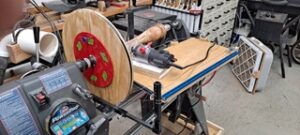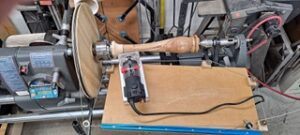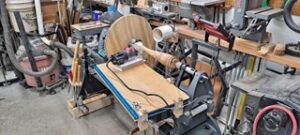If you are using, or building, a spiral fluting jig similar to Bob Grinstead, this page is for you. This page identifies the information you need to use the jig, and provide automatic calculations you will need to perform for jig setup.
To use the Grinstead Spiraling Router, you need to:
- Know the distance the router needs to travel along the spindle
- Decide the twist you would like in the spiral
- Measure the diameter of the narrowest point on the spindle
Once you have decided the distance and twist, you can do some computations to:
- Determine the custom diameter cable wheel needed
- Identify the maximum number of flutes you can have around the spindle (you can create this number of flutes or less without putting the )
The following worksheet will help you compute the custom diameter of the cable wheel you will need and determine the maximum number of flutes you can have on your project. Answer the questions, the table will generate needed output information.
If you would like the original notes on Spiral Jig Setup calculations by Bob Grinstead, click here  .
.
FYI: If you want to know how we computer the Diameter of the cable wheel or the maximum number of flutes you should expect to create, you can look below.
Formulas:
The size of the cable wheel:
- Cable wheel diameter = linear travel distance / ( twist x π)
How many spirals can you have around the vase?
- Given:
- Circumference of smallest diameter = π x smallest diameter
- Then:
- Number of spirals = ( circumference of smallest diameter)/(flute width + space between spirals)
Examples:
How many spirals can you have around the vase?
This is limited by the size of the bit used, the space between the spirals and the circumference of the smallest diameter of the vase. If you attempt to create more than the maximum number of flutes:
- The space between the flutes will be less than minimum space you desire, or
- The flutes may overlap
Example 1
Computing the size of the Cable Wheel …
- Given:
- Distance travel along the spindle is 12″, and
- We want to spiral 1/4 of the distance around the vase (0.25)
- π = 3.14159
- Then:
- The diameter of the Cable Wheel will need to be:
- 12″/(0.25 xπ) = 15.279″ (or 15.28″)
- So, we need a Cable Wheel that is 15.279 inches in diameter
Example 2
Computing the maximum number of flutes possible for the spindle …
- Given:
- The smallest diameter of 1.75 inches
- 1/2 inch wide flute
- 3/8 inch space between flutes
- π = 3.14159
- Then:
- Circumference = π x 1.75 = 5.498 inches
- So,
- Maximum number of spirals = Circumference/(flute width + space between flutes)
- Maximum number of spirals = 5.498 / (0.5 + 0.375)
- 5.498/0.875 = 6.283
- Therefore, don’t expect to create more than 6 flutes (spirals)
NOTE …
Don’t think: “I have a mini lathe and can’t do this or I don’t want to tie up my lathe for this.”
Remember the lathe only holds the piece of wood. You can make a table top version using nearly anything. A couple of bolts on a stand as long as you can hold the wood, turn it by hand and have a platform for the router.



